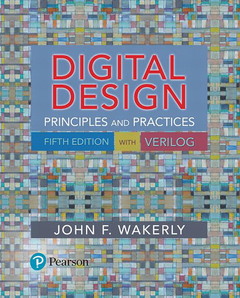Description
Digital Design (5th Ed.)
Principles and Practices
Author: Wakerly John
Language: English
Subject for Digital Design:
912 p. · 24x3.8 cm · Hardback
Description
/li>Contents
/li>Comment
/li>
Establishing a solid foundation of digital design principles
An authoritative introduction to basic digital design, Digital Design: Principles and Practices helps readers build a foundational understanding of theoretical and engineering principles. This book gives readers the opportunity to learn the basics at the high level (HDLs), at the low level (electrical circuits), and throughout the ?vast middle? (gates, flip-flops, and higher-level digital-design building blocks). The author?s 30 years of experience in both industrial and university settings brings weight and credibility to the material, and with broad coverage of logic design practices, the 5th Edition gives readers a look at how digital design works in the real world.
Brief Contents
- Introduction
- Number Systems and Codes
- Switching Algebra and Combinational Logic
- Digital Design Practices
- Verilog Hardware Description Language
- Basic Combinational Logic Elements
- More Combinational Building Blocks
- Combinational Arithmetic Elements
- State Machines
- Sequential Logic Elements
- Counters and Shift Registers
- State Machines in Verilog
- Sequential-Circuit Design Practices
- Digital Circuits
- ROMs, RAMs, and FPGAs
Principles and practices theme
- Students are introduced to the fundamentals, as well as how digital design works in the real world.
- Focused Verilog coverage reduces distractions and gives a more in-depth look at most common language in the industry.
- Coverage of CMOS circuits later in the text makes the book more accessible for non-EE computer engineering students.
- Sidebars discuss important Verilog concepts to make key points stand out for students.
- REVISED! More specific combinational logic coverage splits chapter into three parts to allow classes to skip certain sections, and to provide more focused coverage of state machines and arithmetic circuits.
- NEW! An entire state-machine design chapter focuses on designing state machines in Verilog, using many examples to lay out the process clearly and accurately.
Features for student success
- UPDATED! More contemporary exercises and problems reflect current state of digital design to provide students with relevant scenarios and examples.
- EXPANDED! More HDL examples emphasise design flow and test benches, including purely stimulative and self-checking ones.
- Comprehensive discussions and examples put greater emphasis on FPGA-based design, FPGA architectural features, and synthesis results and trade-offs.
- Synchronous design methodology examples include detailed cases on control-unit-plus-datapath and crossing clocking domains using asynchronous FIFOs.




